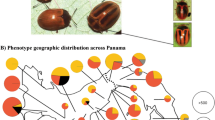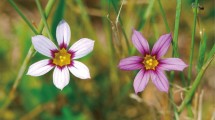Abstract
In twelve populations ofEschscholzia californica from central Chile, where it was introduced in the latter part of the 19th century, there is a regular gradient in frequency of the allelesJ andj, which control orange vs. yellow flowers, ranging from a maximum value of 0.531 to a minimum of 0.160 forJ. Populations having higher values ofJ occupy more mesic sites. In addition, the great majority of the populations have significant excess of heterozygotes over those expected on the basis of theHardy-Weinberg equilibrium, and so exhibit balanced polymorphism for theJ-j pair of alleles, probably associated with heterosis ofJj genotypes. Evidence is presented which suggests that this locus serves as a marker for adaptative gene complexes rather than being itself associated with adaptation. In Chile, the association ofJJ genotypes with cooler, moister habitats is the opposite of the condition existing in California, and suggests that extensive reorganization of the gene pool, through changed linkage relationships, took place asE. californica populations were being established in Chile.
Similar content being viewed by others
References
Almeyda, A. E., ySaez, F., 1958: Recopilación de datos climáticos de Chile y mapas sinópticos respectivos. Santiago: Min. Agricultura DTICA. (Proyecto 14.)
Baeza, V. M., 1930: Los nombres vulgares de las plantas silvestres de Chile y su concordancia con los nombres cientificos. Santiago: El Globo.
Beatty, A., 1936: Genetic studies on the California poppy. J. Hered.27, 330–338.
Da Cunha, A. B., 1949: Genetic analysis of the polymorphism of color pattern inDrosophila polymorpha. Evolution3, 239–251.
Cook, S., 1962: Genetic system, variation and adaptation inEschscholzia californica. Evolution16, 278–299.
Dobzhansky, T., 1951: Genetics and the Origin of Species. 3rd Ed. New York: Columbia Univ. Press.
—, 1970: Genetics of the Evolutionary Process. New York: Columbia Univ. Press.
Douwes, H., 1943: Een genetisch-chemisch onderzoek vanEschscholzia californica. Genetica23, 353–464.
Jain, S. K., andAllard, R. W., 1960: Population studies in predominantly self pollinated species. I. Evidence for heterozygote advantage in a closed population of barley. Proc. Nat. Acad. Sci. U.S.46, 1371–1377.
Meigen, F., 1893: Skizze der Vegetationsverhältnisse von Santiago in Chile. Bot. Jahrb.17, 199–294.
Reiche, K., 1895: Estudios críticos sobre la flora de Chile, vol. 1. Santiago: Cervantes.
Author information
Authors and Affiliations
Rights and permissions
About this article
Cite this article
Frías L., D., Godoy, R., Iturra, P. et al. Polymorphism and geographic variation of flower color in chilean populations ofEschscholzia californica . Pl Syst Evol 123, 185–198 (1975). https://doi.org/10.1007/BF00989403
Received:
Issue Date:
DOI: https://doi.org/10.1007/BF00989403




